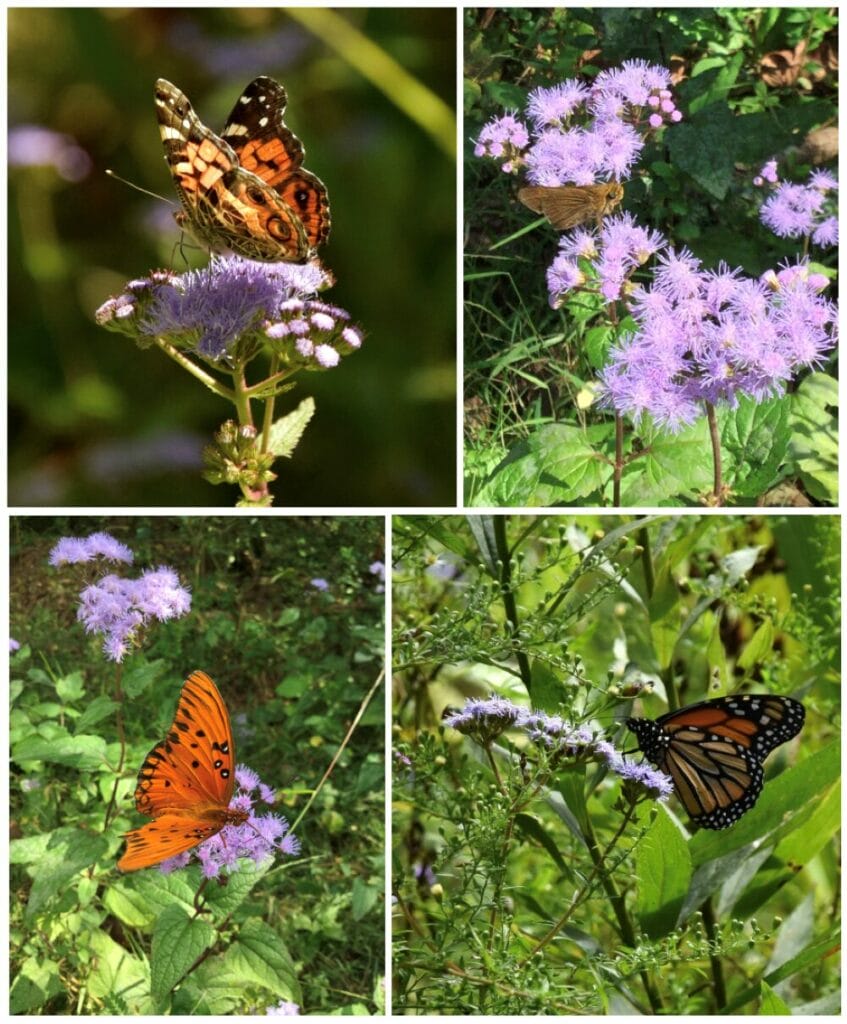By Valerie Boss
The GNPS 2024 Plant of the Year is blue mistflower (Conoclinium coelestinum), a native perennial wildflower with beautiful blue or purplish blossoms. A member of the Asteraceae family, the species can be found throughout the eastern US and parts of Canada in wet bottomlands, ditches, and other areas with plentiful sun and moisture.
The species name for blue mistflower, “coelestinum”, means celestial or heavenly, in reference to blooms the colors of the sky. From late summer through autumn, numerous (up to 70) fluffy disc flowers, each about ½ across, form terminal, flat-topped clusters—landing pads for nectar-loving insects. Butterflies of many species create eye-catching splashes of brown, yellow, and orange against the blossoms’ blue/purple backdrop. Blue mistflower’s nectar also attracts bees, and the plant serves as both a nectar source and host species for several types of moths.
The genus name for blue mistflower has vacillated over the years. In 1753 Linnaeus assigned it to the genus Eupatorium, along with thoroughworts and bonesets, and blue mistflower is still referred to occasionally as blue boneset. In 1836, A.P. de Candolle suggested a new genus name, Conoclinium, derived from the Greek for “little bed”, in reference to the shape of the flower receptacle. However, most botanists continued to use Eupatorium. When modern genetic analyses supported a separate genus for blue mistflower, the name Conoclinium was resurrected.

Many butterflies, including painted ladies (A, top left), skippers (B, top right), fritillaries (C, bottom left) and monarchs (D, bottom right), feed on blue mistflower’s nectar. Photos by Ellen Honeycutt (A, D) and Valerie Boss (B, C).
Blue mistflower is also known as wild ageratum or hardy ageratum. Its flowers strongly resemble those of floss flower (Ageratum houstonianum), an annual garden plant native to Central America. Perhaps the easiest way to distinguish these look-alike species is by their mature leaves. The leaves of A. houstonianum are less than 1” long and spade-shaped, with green veins and scalloped edges. The leaves of C. coelestinum are 1-3” long and ovate-to-triangular shaped, with toothed edges. Leaf veins closest to the stem often have a reddish or purple tint, as do the stems themselves.
As a garden plant, blue mistflower is a fine choice for perennial borders, wetland restoration sites, and moist meadows, where it has room to spread. It makes a wonderful medium-height ground cover. It will grow to 1-3’ wide, with plentiful branching, and up to 3’ tall. In gardens where a shorter plant is preferred, it can be given the “Chelsea chop” (cutting the top 1/3 off) in summer before flower buds appear and will bloom on shortened stems. Blue mistflower grows naturally in full-to-partial sun and heavy, rich earth, although it can thrive in many soil types. Optimally, it prefers moist areas, but can handle moderately dry conditions. The species propagates easily by rhizomes, cuttings, or seeds. It spreads naturally into large swathes, particularly in disturbed ground, and has a tendency to seed itself around the garden. To control re-seeding, the seed heads should be cut before they mature. Blue mistflower pairs beautifully with yellow-flowered species. Patches of it look glorious backed by cut-leaf coneflower, tall goldenrods, or sunflowers.

Blue mistflower pairs with cutleaf coneflower in an herbaceous border. Photo by Valerie Boss.
Plant of the Year shirts are available in our online store. Help us celebrate and spread awareness of these wonderful plants by wearing them!

